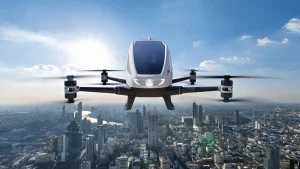The United Arab Emirates is racing to introduce electric vertical take-off and landing (eVTOL) air taxis into its transport system. The General Civil Aviation Authority (GCAA) expects to complete certification by the third quarter of 2026, positioning the UAE among the first nations to regulate commercial flying taxis.

Building the Foundations for Take-Off
The GCAA has already established national regulations for vertiports (the specialised landing sites for eVTOLs) and has introduced a hybrid model, allowing existing helipads to serve both helicopters and electric aircraft. This approach offers a practical route to scale operations without extensive new infrastructure.
Pilot aircraft have also begun testing in UAE conditions. Archer Aviation recently conducted a flight of its “Midnight” eVTOL at Al Bateen Executive Airport in Abu Dhabi, focusing on how the aircraft performs under high heat, humidity, and dust.
Meanwhile, Dubai’s Roads and Transport Authority has partnered with leading aviation and infrastructure companies to create a network of vertiports across the city. Sites include Dubai International Airport, Palm Jumeirah, Downtown Dubai, and Dubai Marina, connecting key destinations that would otherwise take far longer by road.
Why the UAE Is Betting Big on Air Mobility
The push for eVTOLs reflects several priorities:
- Reducing congestion and travel times: Trips that currently take over an hour by car could be cut to just 10–20 minutes by air.
- Sustainability: eVTOLs promise lower emissions and quieter operation, aligning with the UAE’s clean transport and smart city ambitions.
- Economic diversification: Becoming a global hub for advanced air mobility could attract foreign investment, skilled jobs, and technological innovation.
Certification and Timelines
The GCAA’s target of certifying eVTOLs by late 2026 places the UAE ahead of many countries in regulating this emerging industry. However, manufacturers have warned that global certification challenges could still delay large-scale deployment.
Industry leaders say the UAE’s proactive stance makes it one of the most advanced environments for early adoption.
What’s Taking Shape on the Ground
Abu Dhabi plans to host the country’s first hospital-based vertiport at Cleveland Clinic Abu Dhabi, enabling both passenger travel and emergency medical logistics. Several other vertiports are planned across Dubai and Abu Dhabi, forming a connected urban air network designed to launch alongside certification approvals.
Voices Driving the Initiative
According to Saif Al Suwaidi, Director General of the GCAA, the UAE intends to move swiftly once safety and certification standards are met, ensuring the country remains a global front-runner in the next era of urban transport.
How Flying Taxis Could Transform Urban Mobility
If timelines hold, air taxis could change how residents and visitors move across the Emirates:
- Cutting airport-to-city journeys from an hour to minutes.
- Linking major business hubs through direct flight paths.
- Integrating with public transport for multimodal travel.
- Offering a scalable model that could later expand to inter-emirate routes.
A Nation Ready for Lift-Off
With its regulatory leadership, public-private partnerships, and readiness to test new mobility technologies, the UAE is fast turning the vision of flying taxis into a near-term reality. By 2026, what once sounded futuristic may become a regular part of the country’s skyline.











